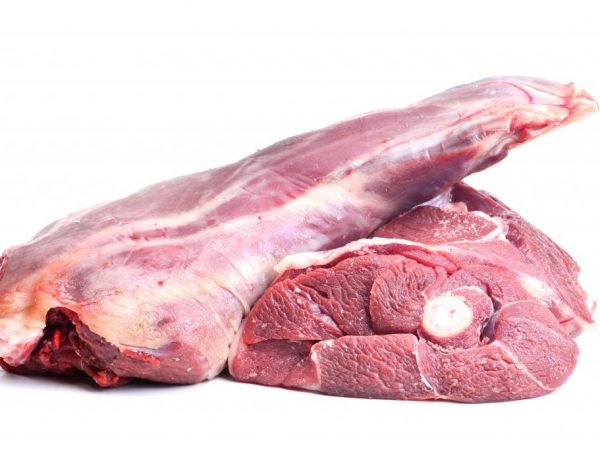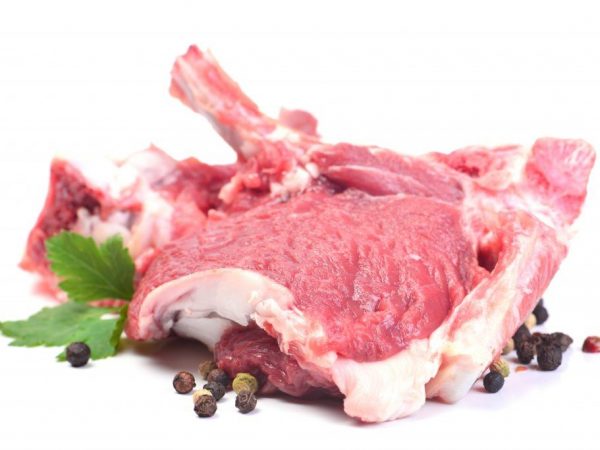Why lamb meat is useful
Animal products are an essential element of the human diet. But there is food that is difficult for domestic gourmets to accept. Why is lamb meat useful and harmful? Let's analyze the main pros and cons of unusual raw materials.

The benefits and harms of lamb meat
What is lamb
Sheep dishes are common in Central Asian countries, the Caucasus and Mongolia. The product is used there for the preparation of both first and second courses. However, the traditional food of those peoples can cause rejection among Europeans who are not used to it.
What is mutton? This is the name of the meat of young animals slaughtered at a certain age. Raw materials of young livestock are suitable for culinary needs. In older individuals, the fibers become tough and acquire a specific aroma, which seems terrible to many untrained gourmets.
According to the current GOST, there is a classification of mutton, dividing products by type.
- Dairy lambs. Tiny animals feed from their mother for up to 2 months. Their meat has a delicate taste and no unpleasant odor.
- Young rams. Animals from 90 days to a year. The most common type used in many kitchens.
- Mature individuals. Age ranges from 12 to 24 months. They have tough fibers, so such meat is most often used in the form of minced meat.
The older the animal, the less pleasant the mutton becomes. Lamb meat is the best option for the first gastronomic acquaintance. It practically does not differ from young beef and at the same time does not fall apart into fibers.
Depending on the breed, the average weight of males ranges from 100 to 180 kg, females are 30% lighter. When buying live volume, the output is one third less meat. The cost of a pure product is influenced by production waste: wool, entrails and limbs.
Content of substances
Why is the product so popular? Raw materials are a unique combination of enzymes and trace elements, which is complemented by a low calorie content. The table details the nutritional value of the main dishes per 100 g of food.
| Name | Kcal | Protein% | Fat% | Water% |
| Boiled | 291 | 21 | 7 | 70 |
| Stew | 270 | 18 | 16 | 65 |
| Roast | 320 | 15,5 | 23,5 | 60 |
The chemical composition of lamb includes vitamins of groups B, E and D. Minerals are the same amount as in beef with pork. Easily assimilable iron is 30% higher than that of its competitors. Additionally, lamb contains:
- magnesium;
- potassium;
- iodine;
- phosphorus;
- sodium;
- calcium.
The increased concentration of protein with a minimum amount of fat makes it possible to use raw materials in dietary nutrition. Consuming wisely will help enrich the menu with a tasty ingredient. On average, 1 kg of flesh per month will provide the body of an adult with important elements.
Beneficial features
Due to its balanced composition, ram meat is considered a healthy delicacy. The high content of B vitamins accelerates metabolism, which has a positive effect on the general tone of the body.Trace elements improve the functions of the central nervous system, prevent stress and stabilize sleep.
Thanks to the unique combination of vitamins and enzymes, the risk of cardiovascular diseases is reduced among lovers of the product. Folic acid supports immunity and is responsible for natural metabolism. By the way, in countries where healthy lamb is a national dish, a large percentage of centenarians are recorded.
The presence of a huge amount of fluoride improves the quality of teeth and does not allow caries to become active. Thanks to vitamins E, D, calcium is absorbed as much as possible, which has an effect on bones and blood vessels. Regular consumption of food will make it possible to forget about joint problems.
By its properties, lamb meat belongs to dietary products. Low cholesterol and minimal fat will not harm your figure. This feature allows you to include tasty, healthy food in the diet of patients with diabetes and obesity.
The lecithin contained in the composition helps to stimulate the digestive system, which is beneficial for people suffering from gastritis and ulcers. The huge amount of iron increases the formation of hemoglobin. Regular consumption of food will be a delicious prevention of blood diseases.
Harmful properties
But is the meat of young lamb so useful? It is worth remembering that this is a very difficult product to assimilate, therefore, its use in the diet of a child under 3 years old and old people is not recommended. Food does not break down well in people's stomachs, causing various digestive problems. If the rules for heat treatment are violated, there is a risk of picking up parasites.
Excess protein during low physical activity reduces benefits and negatively affects weight. The daily intake of meat dishes contributes to the development of sclerosis and obesity. By the way, in the body of sheep there are bacteria that provoke an exacerbation of chronic diseases in humans.
The product contains both solid and saturated fats. They are poorly absorbed by the body and are deposited on the vessels in the form of plaques, and therefore unreasonable abuse will lead to problems in the cardiac system. The product increases the acidic properties of the stomach, which causes gastritis and ulcers.
If you constantly overeat meat, all the benefits will quickly turn into harm. The abundance of calcium and phosphorus has a negative effect on the urinary organs, as a result of which renal diseases become chronic. Impaired elimination of fluid from the body will lead to swelling of the limbs and increased pressure.
If lamb is not a natural food for your family, then you should not suddenly introduce it into the diet. For an unprepared organism, such a dish will be very difficult. It is worth remembering that this is food, not medicine, which needs to be treated.
How to choose
In order for a sheep meat dish to fully reveal its usefulness and taste potential, you need to choose the right piece. Carefulness will help to distinguish a good product from a low-quality one. Fresh raw materials have a light surface covered with thin layers of white fat. The older the animal, the more yellow its fat, and the fibers look brighter and more saturated.
It is worth sniffing the lamb: if it smells unpleasant, this is a sign of the old age of the individual or the usefulness of the male. The castrated young animal lacks a specific, pungent aroma. Such a product will not be useful and can ruin the best dish. The price of such products is often lower than that of other sellers.

Fresh meat has a light surface covered with thin layers of white fat
If you press your finger on the surface of the chilled piece, the dent is quickly smoothed out. The fibers are smooth and do not contain mucus. Frozen versions have no dark spots or blotches.
Sheep meat is not universal, so there is a certain part of the carcass for each type of dish.For boiling and pilaf, it is better to choose a shoulder blade, sternum or neck, and for frying and chops, it is recommended to use a loin and fillet. Oven food lovers opt for the hind leg and saddle.
How to store
Lamb, like pork and beef, is a perishable product. Without low temperatures, microbes develop rapidly inside the fibers. Lost raw materials have a fetid aroma, cloudy mucus forms on the surface, and the color changes to light green.
How much meat is stored? If you keep it on the bottom shelf of the refrigerator, the initial characteristic will not be lost within 48 hours. For a young animal, the shelf life is no more than a day. Safe temperature - no higher than 1 ° С.
Fresh minced meat is allowed to be kept in the chamber for no more than 720 hours, and the presence of herbal additives (onions, garlic, spices) instantly reduces storage: such products are prepared immediately. By the way, many are sure that the marinade increases the duration of being raw. Scientists have proven that bacteria develop in the liquid that harm humans.
Boiled meat should not be stored in broth, as this oversight will significantly reduce the shelf life. Cold fried product loses its taste, so we do not recommend leaving it for later. The specific taste of lamb fat is difficult to soften after reheating.
In the freezer, the product retains its useful properties for 3 months. If the carcass weighs a lot, it is pre-divided into portioned pieces, which are then wrapped in polyethylene. However, gourmets are sure that after defrosting, the aroma and quality of the raw materials deteriorate.
How to cook
Many believe that even the most tender ram meat stinks. Correct cutting will help to get rid of the smell. For this, the film, external fat and tendons are removed from the surface. Too much bacon gives the dish a juiciness, but affects the flavor.
To remove the amber, the raw material must be marinated in the sauce for 10 to 18 hours before heat treatment. Caucasians recommend soaking apples with garlic in juice: such a liquid will kill any negative odors and give the dish an exquisite taste. You should not soak the product in vinegar, as the acid will make the fibers drier and harder. Popular fillings made from wine, yogurt or olive oil.
Sleeve or foil roasting is ideal for lamb. This processing keeps food juicy and soft, while leaving a subtle flavor. Even the simplest food takes on an unexpectedly tender sound. If fried in a pan or grill, the fibers should not be heated for a long time.
If the sheep are cut at home, the fillets may wither. It is better to taste purchased on the market after heat treatment. Boiled goes well with vegetables. With digestive problems, it is recommended to use meat broths, which do more good than harm.
It is advisable to cook lamb for 1.5-2 hours, periodically removing the foam.
So that specific notes do not appear in the dish, you must immediately serve it on the table from the fire. In this case, the fat will not have time to solidify. Gourmets coat pieces of meat with horseradish, mustard and sprinkle with herbs for piquancy. Spices and aromatic herbs make food tastier and more flavorful.
Contraindications
Lamb, like pork, is difficult to digest. To neutralize harm, you should carefully consider the choice of food. If you are obese, you need to look for lean meats that should not be overused.
Animal food increases acidity and makes digestion difficult. Any chronic diseases of the kidneys, liver and gastrointestinal tract can worsen. The abundance of calcium and fluoride is dangerous for people with atherosclerosis, gout, and arthritis. Before use, consultation with a therapist is required.
You should not feed lamb to the elderly and toddlers under the age of 3 years.In this category of the population, the digestive system does not function at full strength and cannot cope with the processing of coarse fibers. Constant use will provoke the emergence of dangerous diseases that quickly turn into a chronic state.
It is better not to conduct the first acquaintance with sheep dishes on your own. Recommend to try food prepared by a specialist. Compliance with the processing rules will relieve frustration and make healthy food a favorite.
Lamb is a favorite in the cuisines of many nations, however, compatriots gradually tasted its aroma. Excellent taste and chemical characteristics made the raw material a good alternative to the usual pork. Our recommendations will help determine the harm and benefits of the product.


